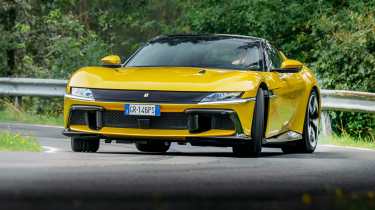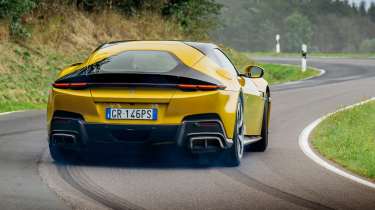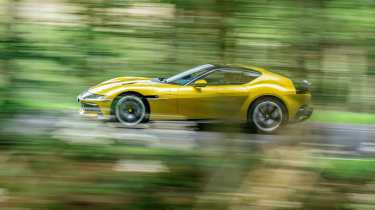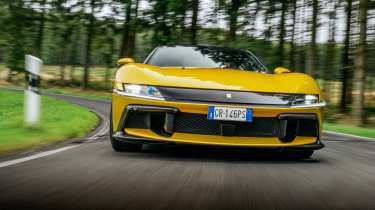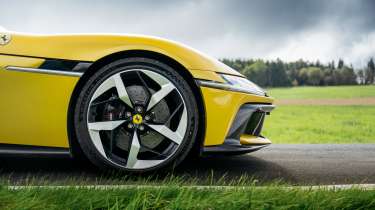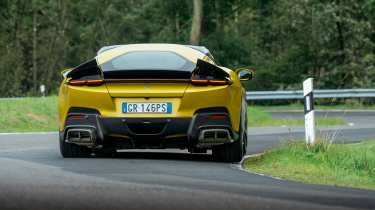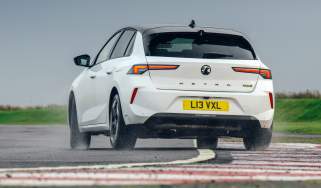Ferrari 12 Cilindri 2025 review – 819bhp super GT tested on road and track
Ferrari describes its 819bhp, V12-powered 12 Cilindri as the most complete GT it’s ever made. We try it for the first time at its international launch
It’s been filthy weather ever since I first dropped into the new Ferrari 12 Cilindri’s low-set driving seat, but, as if by some divine coincidence, the mist rises and the sky begins to clear shortly after we cross the German border and pass a sign with those four tantalising diagonal strips that demarcate an unrestricted stretch of autobahn. Smoothly opening the throttle pedal to its stop in any high-performance car is quite a moment, but when that car has 12 cylinders and revs to 9500rpm…
In this case, though, it’s more than an engine, and more than a car, isn’t it? The two things together are more than the sum of their parts here because a Ferrari is one thing, but a V12 Ferrari… that’s a thing in and of itself, both in automotive culture and to Ferrari as a marque – the first Ferrari in 1947 had 12 cylinders, and ‘everything since is a derivation’, as Enzo Ferrari once put it.
> Aston Martin Vanquish 2024 review - Britain’s Ferrari 12 Cilindri rival
Perhaps that’s why Ferrari has chosen to name its latest V12-powered car after the engine itself. The 12 Cilindri (which sounds a lot better pronounced in Italian, or the closest an English-speaker can get to it phonetically at least: doe‑dee‑chee chill‑in‑dree, or ‘12 cylinder’ to you and me) is the successor to the 812 Superfast. When that car’s 812 Competizione evolution was launched in 2021, evo’s Adam Towler wondered rhetorically whether it would be the last naturally aspirated V12 Ferrari of its kind.
More reviews
Happily, it wasn’t. The 12 Cilindri is powered by a derivation of the 812 Comp’s 6.5-litre, 65-degree V12 and still does without turbochargers and hybrid assistance yet develops 126bhp per litre. Peak power – reached at 9250rpm – is 819bhp. Both fixed-roof berlinetta and convertible Spider versions have gone on sale concurrently, priced at £336,500 and £366,500 respectively, though deliveries of the Spider won’t start until around six months after those of the closed car; all of the examples here at the international media launch are berlinettas.
The 12 Cilindri’s bloodline goes back to the 550 Maranello, with the 599, F12 and 812 in between, so there’s some serious heritage to draw on. Whereas the F12 and 812 were intense machines – almost front-engined hypercars in character – the 12 Cilindri’s remit is to be a more well-rounded grand tourer with a greater range of abilities. ‘It is our expression of what a front-engined V12 Ferrari can be in 2024,’ is how chief test driver Raffaele de Simone puts it.
As with other modern Ferraris, it fires not from a button but a haptic touch surface, which robs a little tactility from the start-up ritual. But the sense of thrill and anticipation is still very much there: this brand-new V12 Ferrari is all ours, for a few hours at least. In – Sod’s Law – sodden conditions when we first set off from the launch’s Luxembourg base in pre-dawn gloom. Before we can strike out and explore both the car and the surrounding rolling hills, first of all we head for Goodyear’s nearby tyre testing centre. The tyre maker’s partnership with Ferrari for the 12 Cilindri is the reason behind this unusual launch location – the new car is the first Ferrari since the F50 to be shod with Goodyears, with Michelins also available depending on the market and customer preference.
‘Our’ car is fitted with the Michelin Pilot Sport S 5 due to logistical supply issues with the bespoke new Eagle F1 SuperSport, though when we get to the track we’ll temporarily switch to a car on the Goodyears. The Michelins are doing a decent job of finding purchase on the cold, slimy tarmac. Impenetrable mist makes the rainfall look like ink and as we join early morning traffic it’s hard to see more than a few metres ahead.
All of which accentuates the first impression that the 12 Cilindri is a wide car, and one with arresting proportions. This isn’t a design magazine per se and you’ll have your own impressions but, for what it’s worth, the first time I saw the 12 Cilindri in pictures I wasn’t sure; I didn’t feel immediately captivated by it in the way I had been with some other recent Ferraris. Nor when I saw it in real life for the first time, briefly, during a tour inside the Maranello factory. However, meeting it properly, outdoors, in natural light – very lovely natural light at that, as we were introduced to the car under late-summer sun the day before the drive, with plenty of time to drink in its details in three dimensions – it looks different. And, I must say, quite stunning.
The nods to the ’60s Ferrari Daytona stand out immediately but it’s the clean surfacing that holds your eye, divided into upper and lower shapes separated by a central diagonal line. The ‘delta’ graphic at the rear of the roof, where the black colour-break blends into the rear window to create a chevron of body colour, is easier to read in real life, too. Lead exterior designer Andrea Militello points out that the 12 Cilindri’s surfaces have been designed to capture fewer reflections than other, curvier Ferraris, giving it a distinct appearance from the rest of the range. The designers were encouraged to seek inspiration from outside of cars, including sci-fi influences: ‘Part of the brief we were given was, “How would you imagine a Ferrari that goes in space?”’ Militello says.
It might as well be a spaceship, among the vans and SUVs on the early morning commute. Trundling in traffic gives us time to take in the 12 Cilindri’s cabin. As with the Roma and Purosangue, the dashboard is split into dual ‘zones’ for driver and passenger. The passenger gets their own screen, with revs, speed, media and so on. The driver sits behind a 15.6-inch digital instrument panel, while the central touchscreen – for nav, climate, media and so on – has been designed with the intention that when it’s switched off it blends into the rest of the dashboard. It’s the opposite approach to cars that sit their screens on standalone armatures, tablet-style. Aside from the nose-lift control on the central touchscreen, most of the car’s functions are accessed from the steering wheel. On the downside, the wheel still has haptic touchpads on its spokes like other modern Ferraris. On the upside, they now have indents to make it easier to find the control you’re after without taking your eyes off the road, and Apple CarPlay and Android Auto are more neatly integrated than ever so there’s little reason to recourse to Ferrari’s own, fiddlier interfaces.
As with all modern-era Ferraris, the hyper-responsiveness of the steering and brakes takes a couple of miles to adapt to. You steer with your wrists rather than your arms and the brake-by-wire system is coupled with a short, sharp pedal action, too. Despite its relatively large dimensions, the sense that this is a nimble car is immediate. But not only because of its hyper-sensitive controls; it’s inherent in the car itself. Weight distribution is around 48:52 front:rear, and there’s a sense of the car pivoting in the middle around you. The V12 sits behind the front axle line but the 12 Cilindri feels so wieldy you almost believe it could be sitting behind your shoulders.
We’ve barely troubled the V12 so far, spinning sotto voce at low revs. That will change shortly, as we roll through the gates of Goodyear’s test centre. As a test track rather than a race circuit, it’s full of constant-radius corners, one of which is traversed by some mid-corner bumps to measure the tyres’ deflection. Switching temporarily to another 12 Cilindri fitted with the new Goodyears, I have four laps to follow Ferrari test driver Matteo, who isn’t hanging about. It’s fascinating to follow him, watching his car lose and regain grip on the greasy surface, and feeling mine do the same moments later. The 12 Cilindri is not edgy in the way it relinquishes grip, and when it does slide, it regains balance swiftly. The F1 SuperSports, which took 18 months to develop, are not special track tyres; like the Michelins, they are designed to be good all-round performance tyres for road use, in keeping with the 12 Cilindri’s gran turismo remit. It’s not intended to be a track car but, for context, de Simone says it’s around 1 to 1.5 seconds a lap slower around Fiorano than a 296 GTB, but ‘way faster’ than an 812.
On the circuit’s long, wide straight there’s the chance to run all the way to the 9500rpm red line. The 12 Cilindri is still accelerating strongly at 180mph when we approach the braking point and back off. Top speed is quoted as ‘more than’ 211mph. The final drive is lower than the 812’s but top (eighth) gear is longer, the better for emissions. Gearshifts are 30 per cent faster and de Simone says Ferrari has worked to make downshifts feel more thrilling, with a more instantaneous response and sense of connection.
In third and fourth gear, the 12 Cilindri uses ‘Aspirated Torque Shaping’, whereby the torque curve is electronically controlled so that there’s a constant feeling of crescendo. Although 80 per cent of the maximum 500lb ft is available from as little as 2500rpm, the torque delivery is carefully tuned from 2000rpm all the way north of 7000rpm. De Simone describes the handover from the torque curve to the power curve in a one-gear run from 2000 to 9000rpm as like a space shuttle, where one set of boosters falls away and the next takes over. Ferrari first productionised torque-shaping tech on the 488 GTB, to get around the feeling of turbo lag, but this is the first time it’s employed the system in a naturally aspirated engine.
Following Matteo’s 12 Cilindri, I can see the active aerodynamic flaps on his car’s rear flanks activate during hard cornering. When longitudinal or lateral acceleration reaches a certain threshold, surfaces ahead of the rear lights deploy to an angle 10 degrees to the horizontal. They lift in unison, rather than individually à la Pagani Huayra. They’re capable of generating 50kg of downforce at 155mph and can shift the aerodynamic balance a little to the rear, aiding stability in fast cornering.
As we’re about to get a direct demonstration of, with a quick passenger ride with chief test driver de Simone. There’s one particularly treacherously fast section of the track, asking a direction change of the car while it’s heavily loaded. ‘Through there, I do not want oversteer,’ de Simone says, explaining that the wings shift the balance subtly to the rear, giving him stable understeer to lean on. ‘Whereas through here,’ he says, as we enter a long, low-to-medium-speed hairpin, ‘I don’t want the wings to be active, so that I can play with the car.’ He seamlessly puts the car into a powerslide, which he’s seemingly able to hold indefinitely, while also holding a conversation (all the more impressive because some of the time he takes a hand off the wheel to gesture as he chats).
The 12 Cilindri uses Ferrari’s latest Side Slip Control software, in conjunction with a six-way chassis sensor system actively measuring and predicting the car’s movements and monitoring the slip of each individual wheel. You can still switch it all off but, as with other Ferraris, you’ll be quicker with it on. Stability is also aided by four-wheel steering. Unlike that of some other manufacturers, the rear wheels never turn the opposite way to the fronts; the system is used only to virtually lengthen the wheelbase at higher speeds.
Our allotted time at the circuit is over and the 12 Cilindri is more of an open book than before, but there’s still a lot to discover. We climb back into our Michelin-shod car and strike out over the border to Germany, to roads we know well – via that brief but exhilarating stretch of empty autobahn. As de Simone says, a run from 2000 to 9000rpm-plus is quite an experience.
The new engine – named the F140 HD – has had no effort spared. As with the unit in the 812 Competizione, it features sophisticated valvegear, titanium con-rods, lightweight pistons with a low-friction coating and a lighter crankshaft than the Superfast’s engine. The 12 Cilindri has an all-new exhaust system, and a new intake plenum with variable-length intake ducts. The oil pump system has also been redesigned and the fuel injection likewise.
The two six-into-one exhaust manifolds and the geometry of the exhaust system beyond have been carefully designed to ensure the V12 sounds as sweet as possible (and there are exhaust resonators that transmit sound from just ahead of the throttle body intake). It does sound lovely, it really does, although subjectively it’s not as memorable as some other Ferrari V12s. It’s a modern engine with all the requisite emission and noise measures to cater for all markets, including a new ceramic catalytic converter and anti-particulate filter, so of course it can’t quite sound like a classic V12 of old. It’s not as spine-tingling a sound as the Ferrari 275 GTB dubbed for C’était un Rendezvous (I just paused writing to watch that again on YouTube, feel free to pause reading to do the same), nor the V10 Lexus LFA. It’s a smooth, cultured note but not a raucous one, in keeping with the 12 Cilindri’s role as a GT.
The team behind the 12 Cilindri describe it as the most capable Ferrari gran turismo of all time, and its bandwidth is greater than that of its direct predecessors. It’s a refined car, one that covers ground with ease. It has a slightly firm ride for a GT, though. The magneride ‘semi-active’ dampers have been designed to give less roll on track yet more comfort on the motorway, and the overall ride quality is excellent, but there’s a sense it might feel a tad firm on roads away from the sympathetic surfaces of the launch routes unless you press the manettino switch to access the softer ‘bumpy road mode’. We’ll have to wait and see.
A good part of the 12 Cilindri’s bandwidth is still focused on being a thrilling driver’s car as well as a GT. The weather is now cloudy but dry, and the grip the Ferrari generates is remarkable. Some of Aston Parrott’s photos show fresh air under the tyres while cornering hard. It’s a car you can really dig in with; it settles quickly in the first phase of a corner, and since the engine’s delivery is so linear you can get on the throttle early, leaning hard on the huge level of lateral grip. Yet despite all of that grip, it’s still a playful car. It responds like a lightweight mid-engined sports car rather than a large front-mid-engined GT car. You revel in the swiftness with which it responds as one, with zero slack.
And it’s not the computers doing all of this for you, either. I’m a bit intimidated the first time I need to switch off the traction and stability control to get an essential gratuitous sideways photo, but the 12 Cilindri’s grip, traction and smooth torque delivery make it trustworthy as well as exciting. Despite all of the technology at play, it’s clear that this is a mechanically well-sorted car too.
Downsides? I feel like I’m the wrong shape for the seats; I can’t quite get the support I need for my shoulders and upper back, and when I set the base of the seat at a comfortable distance for my legs, I find the wheel is now a bit of a stretch. Low-speed manoeuvring isn’t helped by the large turning circle and enormous blind spots; the (excellent) camera system is essential for parking.
We push our time with the car as long as we can and get back to the launch base just in time for curfew. Although we’ve covered more than 200 miles, on track, on motorway, on rural roads, in traffic and running free on quiet roads, I still feel like we’re just getting to know the 12 Cilindri. Those with far more wheel-time in its predecessors, the F12 and 812, go a little wide-eyed at the memory, describing them as intense, dramatic cars. There’s less immediate drama and intensity here, but I’m quite captivated by the 12 Cilindri. Speaking of the car’s design, Ferrari’s design director Flavio Manzoni describes it as ‘an object that might catch you off guard at first, but once you understand it you fall in love with it. If you love a design straight away, sometimes you get bored of it quickly; you want it to grow into you.’
I think the 12 Cilindri as a whole is a little like that; a car you need to spend time with to fully appreciate. The 4.5-star evo rating is based on a tight timescale with the car. It could well be a 5-star car with longer exposure.
Happily, Ferrari says it hasn’t named the car after its engine because it’s a swansong for the V12; it will keep building V12-powered cars for as long as it is feasible to do so, and there’s no suggestion that this will be the last. The 12 Cilindri is an intriguing car with a unique personality, quite unlike any other current Ferrari, or any other GT car or front-engined supercar, in fact. It wears its name well.
Ferrari 12 Cilindri specs
| Engine | V12, 6496cc |
| Power | 819bhp @ 9250rpm |
| Torque | 500lb ft @ 7250rpm |
| Weight | 1560kg (dry) |
| Power-to-weight | 533bhp/ton |
| Tyres as tested | Michelin Pilot Sport S 5 |
| 0-62mph | 2.9sec |
| Top speed | 211mph+ |
| Price | £336,500 |
| Star rating | 4.5 |
This story was first featured in evo issue 327.
